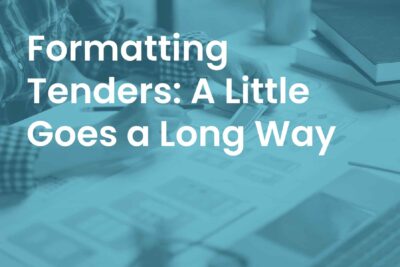
Bid writing can be intimidating from start to finish. There are all these documents with long obscure names that don’t explain what they’re for, (this happens more often than you think), and we are now on version 4 of the instructions and version 5 of the pricing schedule and it is only the end of the first week!
Stay calm and start at the beginning with the documents themselves.
1. Split the Documents Up
If there are a lot of documents, split them up into folders to make it easier to find them. For example, if the client has decided to issue the ITT documents for information only, alongside the SQ then put them aside for the time being. Concentrate on the SQ and the docs that are relevant now.
Most importantly, if you have a client who keeps issuing revised versions of various documents, make sure that you file away the old ones and send out the latest version to anyone who needs it as soon as the latest has been received. This is particularly important with pricing schedules where using the wrong version could mean your submission will be rejected.
2. Read the Instructions
There will usually be instructions that tell you what to do to have a compliant submission. Read these and follow them. If you do not understand any of the instructions or there are errors, contradictions or missing information, ask questions to get clarity.
3. Check for Signatures Required

There are almost always signatures needed for whatever stage you are at. Check how many you need and who is required to give them. You should also check whether they want “wet” signatures (signed in pen and then scanned in). For “wet” signatures, make sure to leave yourself and the signatories enough time to do this.
4. Read the Questions
Don’t just dive in and start trying to answer them. Whether it is an SQ or ITT read it through first. Check for the following:
- Do you need to submit any documents with it such as accounts, insurance details, accreditations?
- If it is an SQ, are there any questions that require written answers, (e.g. questions about your health and safety or quality management), or is it all Yes/No responses?
If the submission is entirely online, check those with Yes/No tick boxes to make sure there are no hidden questions that pop up depending on what you tick. For example, you may have a question that asks if you have a certain accreditation and if you tick No a further question then appears asking you for further information.
5. Assign the Questions
If it is part of your process that questions are assigned to different individuals to write responses, ensure that this is done as soon as possible and that deadlines are set for the return of first drafts.
Now ask yourselves:
6. Do You Need Internal Approvals?
If your internal governance requires approval from certain individuals (typically for financials), make sure that they are notified as soon as possible that they will be required and agree a date for final approval. Make sure that all who need to know are aware that they must be ready by that date.
7. Do You Need a Hard Copy?
If you are required to produce hard copies think about how you are going to do this. Again, decisions about printing and document design need to be discussed by all those involved as early as possible and this includes your printer. A good printer may also be able to provide you with assistance with design, layout and so on.
The Finish Line

So, everything is now finished in terms of writing responses, filling in boxes, finances signed off and printing done where necessary. The most important thing now is to make a final check that you have everything you need to submit a compliant bid.
Portal Submissions
Make sure before you submit that you have filled in all responses required and have attached any documents required. Although most portals are set up to prevent incomplete submissions you should make a check anyway.
Hard Copy Submissions
Again, check you have all the documents you need to submit and the right number of copies. Make sure that anything requiring signatures has been signed.
Crucially, make sure you follow any instructions about how the package is to be labelled. They might have included their own or have provided a title that is to be on the package to identify it as a tender. Make sure you have the right address.
Email Submissions
If it is necessary to send your submission on more than one email then ensure:
- Emails are titled either as per any instructions or are clearly labelled ITT or SQ SUBMISSION
- They are clearly numbered (e.g. 1 of 4, 2 of 4 etc).
- The message clearly lists the documents attached.
- Attachments do not exceed file size limits stated by the client. If no limit is specified, attach no more than 5mb to each email to be safe.
- Always ask the client for acknowledgement of receipt.
Now hit the submit button/hand over to the courier/press the send button. You’re done. Bravo you made it to the finish!
Did you enjoy this post?
Click here to learn more about how to design the perfect tender.
Follow Bespoke Bids on Linkedin to keep up with our day-to-day operations. We post live tenders, tips and tricks and more.


